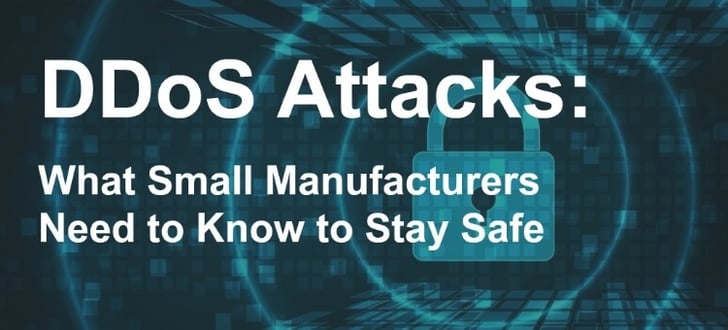March 30, 2017 | Cybersecurity
DDoS Attacks: What Small Manufacturers Need to Know to Stay Safe

This past October, a major DDoS attack occurred which put many popular websites such as Netflix, PayPal and Reddit out of service. A Distributed Denial of Service attack, or DDoS, occurs when multiple systems flood the bandwidth or resources of a targeted system, usually one or more web servers. Such an attack is often the result of multiple compromised systems (for example, a botnet) flooding the targeted system with traffic.
These attacks aren’t limited to major websites, either. Anybody can be a target. If DDoS attacks are one of the last things on your manufacturing mind, then now might be a good time to start preparing in case your business is targeted by cybercriminals.
That’s because they’re increasing by more than 125 percent, year by year, according to a Q1 2016 State of the Internet-Security Report by Akamai, a content delivery network company. More disconcerting still is that an earlier Q3 2015 report revealed the increase was found to be 180 percent against small businesses.
The vast majority of manufacturing operations in the United States are smaller firms. As mentioned in a recent blog, threats to cybersecurity involving DDoS or other attacks pose a unique threat to small and medium-sized businesses. This is because they feature more digital assets to lose than individual computer users but have far fewer resources to protect themselves than large companies.
What happens if you get DDoS attacked?
The only possible silver lining to a cyber-attack successfully leveled against one’s business might be that “it could have been worse.”
The only silver lining to a cyber-attack successfully against one’s business might be that it could have been worse.DDoS attacks cost small businesses who’ve suffered a hit an average of $52,000, according to cybersecurity and anti-virus provider Kaspersky Labs. However, given the range of diversity involved in manufacturing, with various processes and levels of automation, a cybersecurity attack may have the potential to be even more costly.
Indications that your manufacturing operation may be experiencing a DDoS attack include:
- Lots of spam
- A large number of customer inquiries from abnormal channels
- Very slow page-load times
- Transaction failures
- Complete disruption of internet service
A DDoS attack can affect manufacturers in several ways. First, it can restrict access to your site, forcing customers to turn to your competitors. Second, a DDoS attack can make it difficult for you to access business tools that you need to do your job, such as email or RFx hosting. Finally, a successful DDoS attack can compromise your IoT devices.
So how can manufacturers prepare themselves for a DDoS attack?
Staying safe:
- Have a game plan. Assume it’s not a matter of if someone may attack your system, but when. Talk to your own personnel and to your web host vendor. That way, everyone is on the same page in such an event. You’ll want to know the cost if your web traffic spikes when attacked.
- Software and hardware designed to deal with attempted DDoS attacks is available. Having the right equipment is a good idea for 2017.
- Don’t make it easy for hackers. Fragment your operational IT infrastructure from your customer data and access.
- Contact the authorities – the FBI or local law enforcement. The hackers that attack you may have a history. Reporting an attack can help prevent attacks in the future.
- Backups, backups, backups! Make them full and make them frequent. That way, in case you have to start with another service, you can have a better start.
Remember, DDoS attacks can happen to anyone, not just the big guys. Now is the time for small and medium-sized manufacturers to protect their supply chain.

